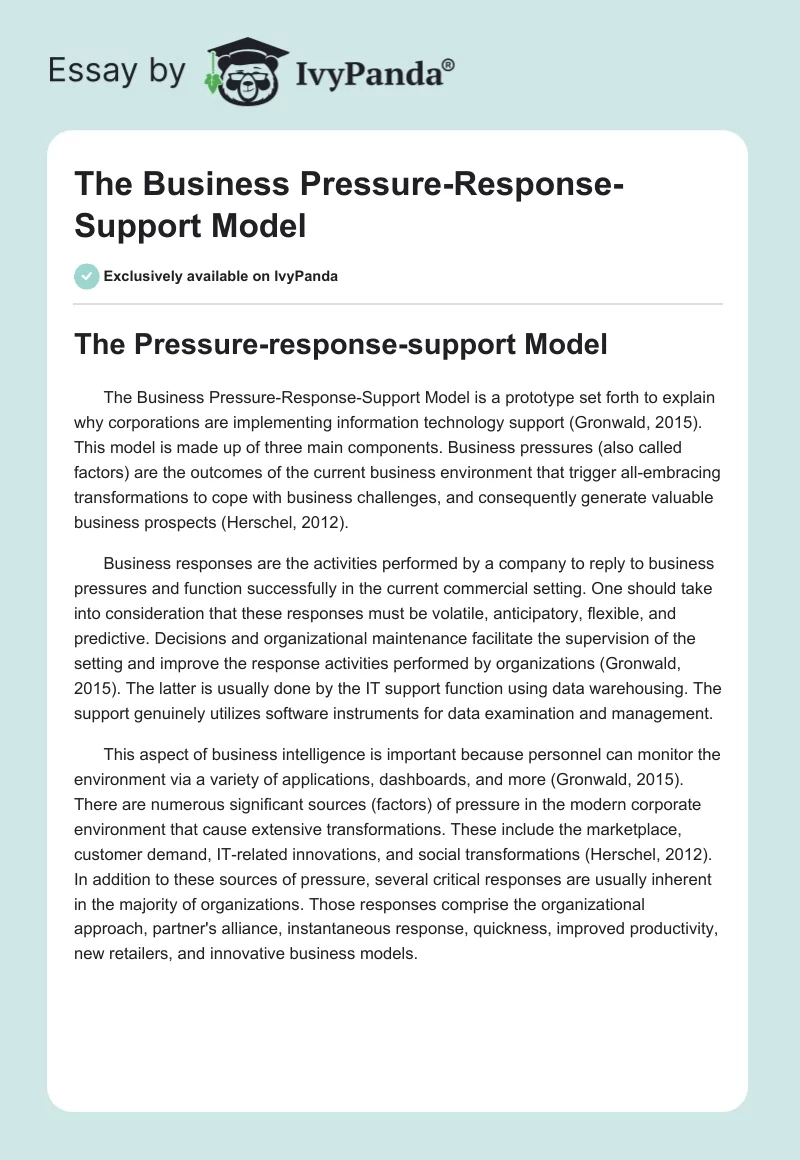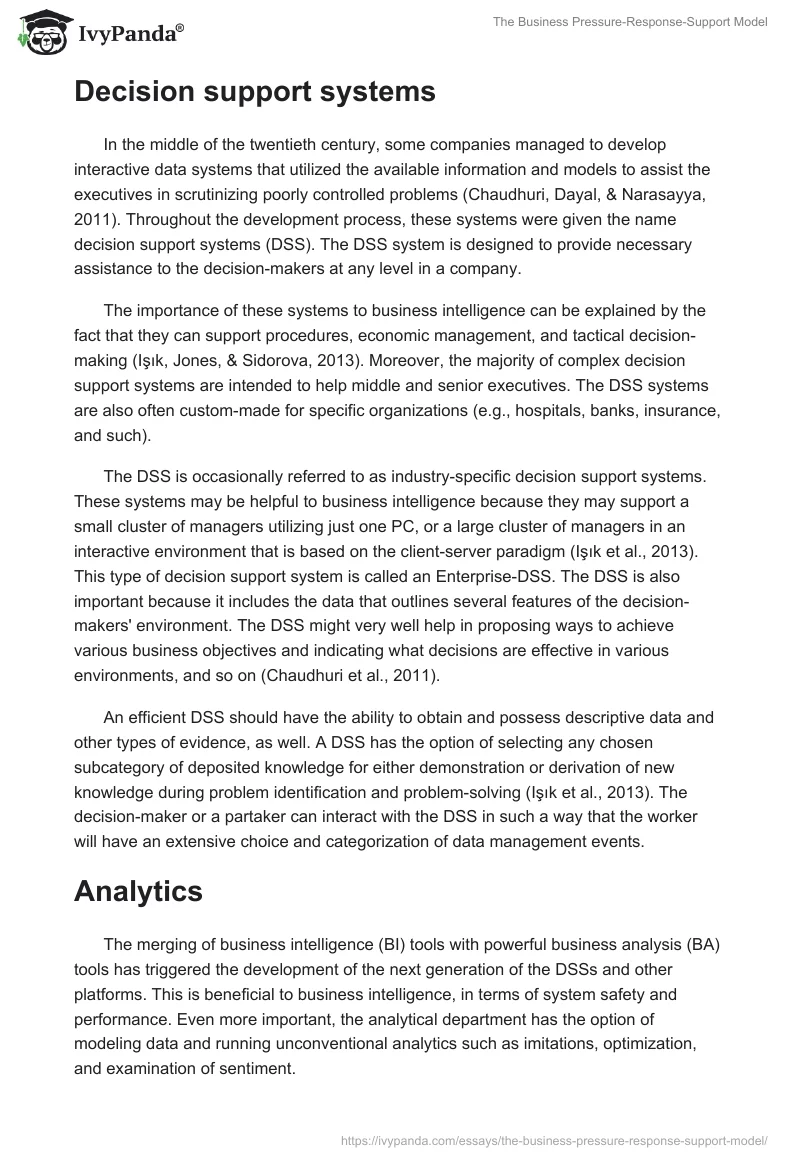The Pressure-response-support Model
The Business Pressure-Response-Support Model is a prototype set forth to explain why corporations are implementing information technology support (Gronwald, 2015). This model is made up of three main components. Business pressures (also called factors) are the outcomes of the current business environment that trigger all-embracing transformations to cope with business challenges, and consequently generate valuable business prospects (Herschel, 2012).
Business responses are the activities performed by a company to reply to business pressures and function successfully in the current commercial setting. One should take into consideration that these responses must be volatile, anticipatory, flexible, and predictive. Decisions and organizational maintenance facilitate the supervision of the setting and improve the response activities performed by organizations (Gronwald, 2015). The latter is usually done by the IT support function using data warehousing. The support genuinely utilizes software instruments for data examination and management.
This aspect of business intelligence is important because personnel can monitor the environment via a variety of applications, dashboards, and more (Gronwald, 2015). There are numerous significant sources (factors) of pressure in the modern corporate environment that cause extensive transformations. These include the marketplace, customer demand, IT-related innovations, and social transformations (Herschel, 2012). In addition to these sources of pressure, several critical responses are usually inherent in the majority of organizations. Those responses comprise the organizational approach, partner’s alliance, instantaneous response, quickness, improved productivity, new retailers, and innovative business models.
Decision support systems
In the middle of the twentieth century, some companies managed to develop interactive data systems that utilized the available information and models to assist the executives in scrutinizing poorly controlled problems (Chaudhuri, Dayal, & Narasayya, 2011). Throughout the development process, these systems were given the name decision support systems (DSS). The DSS system is designed to provide necessary assistance to the decision-makers at any level in a company.
The importance of these systems to business intelligence can be explained by the fact that they can support procedures, economic management, and tactical decision-making (Işık, Jones, & Sidorova, 2013). Moreover, the majority of complex decision support systems are intended to help middle and senior executives. The DSS systems are also often custom-made for specific organizations (e.g., hospitals, banks, insurance, and such).
The DSS is occasionally referred to as industry-specific decision support systems. These systems may be helpful to business intelligence because they may support a small cluster of managers utilizing just one PC, or a large cluster of managers in an interactive environment that is based on the client-server paradigm (Işık et al., 2013). This type of decision support system is called an Enterprise-DSS. The DSS is also important because it includes the data that outlines several features of the decision-makers’ environment. The DSS might very well help in proposing ways to achieve various business objectives and indicating what decisions are effective in various environments, and so on (Chaudhuri et al., 2011).
An efficient DSS should have the ability to obtain and possess descriptive data and other types of evidence, as well. A DSS has the option of selecting any chosen subcategory of deposited knowledge for either demonstration or derivation of new knowledge during problem identification and problem-solving (Işık et al., 2013). The decision-maker or a partaker can interact with the DSS in such a way that the worker will have an extensive choice and categorization of data management events.
Analytics
The merging of business intelligence (BI) tools with powerful business analysis (BA) tools has triggered the development of the next generation of the DSSs and other platforms. This is beneficial to business intelligence, in terms of system safety and performance. Even more important, the analytical department has the option of modeling data and running unconventional analytics such as imitations, optimization, and examination of sentiment.
The latter is done to take advantage of the reflexive data that is usually stored in traditional business intelligence tools. The quality of BI and BA models is directly contingent on the quality of the original data (Lahrmann, Marx, Winter, & Wortmann, 2011). The creation of databases, in terms of absolute volume, miscellany, and real-time accessibility, means that the companies are trying to exploit the most intricate and unstructured information. Business analysis tools are still considered to be the best option when it comes to the processing of disorganized data in an organized format for future reporting and business investigation by end-users (Lahrmann et al., 2011).
Nevertheless, there is an increasing tendency to get rid of large data clusters and substantial data processing in favor of the platforms that support a big data format (Popovič, Hackney, Coelho, & Jaklič, 2012). When talking about analytics, business intelligence will be beneficial for many organizations worldwide. BI makes it possible to examine ancient data from numerous systems using statistical breakdown. It supports extrapolative modeling and other methods to recognize tendencies and comprehend the data that can transform business and support positive business growth.
References
Chaudhuri, S., Dayal, U., & Narasayya, V. (2011). An overview of business intelligence technology. Communications of the ACM Commun. ACM, 54(8), 88-90. Web.
Gronwald, K. (2015). Business intelligence (BI) und big data analytics (big data). Integrierte Business-Informationssysteme, 4(1), 51-55. Web.
Herschel, R. T. (2012). Organizational applications of business intelligence management: Emerging trends. Hershey, PA: Business Science Reference.
Işık, Ö, Jones, M. C., & Sidorova, A. (2013). Business intelligence success: The roles of BI capabilities and decision environments. Information & Management, 50(1), 13-23. Web.
Lahrmann, G., Marx, F., Winter, R., & Wortmann, F. (2011). Business intelligence maturity: Development and evaluation of a theoretical model. Business Intelligence Journal, 13(15), 143-147. Web.
Popovič, A., Hackney, R., Coelho, P., & Jaklič, J. (2012). Towards business intelligence systems success: Effects of maturity and culture on analytical decision making. Decision Support Systems, 54(1), 729-739. Web.



